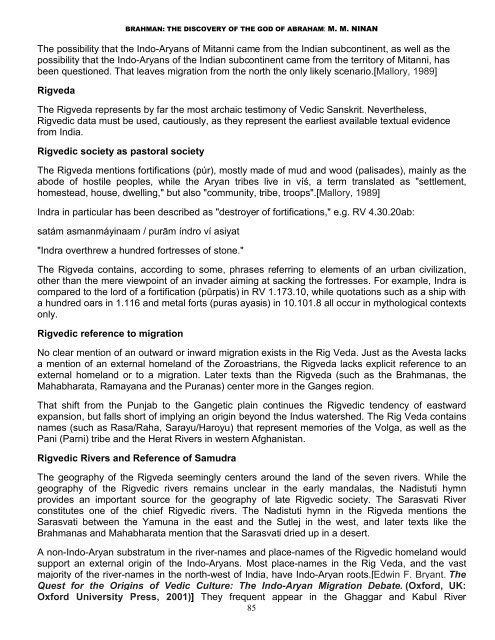Create successful ePaper yourself
Turn your PDF publications into a flip-book with our unique Google optimized e-Paper software.
BRAHMAN: THE DISCOVERY OF THE GOD OF ABRAHAM: M. M. NINAN<br />
The possibility that the Indo-Aryans of Mitanni came from the Indian subcontinent, as well as the<br />
possibility that the Indo-Aryans of the Indian subcontinent came from the territory of Mitanni, has<br />
been questioned. That leaves migration from the north the only likely scenario.[Mallory, 1989]<br />
Rigveda<br />
The Rigveda represents by far the most archaic testimony of Vedic Sanskrit. Nevertheless,<br />
Rigvedic data must be used, cautiously, as they represent the earliest available textual evidence<br />
from India.<br />
Rigvedic society as pastoral society<br />
The Rigveda mentions fortifications (púr), mostly made of mud and wood (palisades), mainly as the<br />
abode of hostile peoples, while the Aryan tribes live in víś, a term translated as "settlement,<br />
homestead, house, dwelling," but also "community, tribe, troops".[Mallory, 1989]<br />
Indra in particular has been described as "destroyer of fortifications," e.g. RV 4.30.20ab:<br />
satám asmanmáyinaam / purām índro ví asiyat<br />
"Indra overthrew a hundred fortresses of stone."<br />
The Rigveda contains, according to some, phrases referring to elements of an urban civilization,<br />
other than the mere viewpoint of an invader aiming at sacking the fortresses. For example, Indra is<br />
compared to the lord of a fortification (pūrpatis) in RV 1.173.10, while quotations such as a ship with<br />
a hundred oars in 1.116 and metal forts (puras ayasis) in 10.101.8 all occur in mythological contexts<br />
only.<br />
Rigvedic reference to migration<br />
No clear mention of an outward or inward migration exists in the Rig Veda. Just as the Avesta lacks<br />
a mention of an external homeland of the Zoroastrians, the Rigveda lacks explicit reference to an<br />
external homeland or to a migration. Later texts than the Rigveda (such as the <strong>Brahman</strong>as, the<br />
Mahabharata, Ramayana and the Puranas) center more in the Ganges region.<br />
That shift from the Punjab to the Gangetic plain continues the Rigvedic tendency of eastward<br />
expansion, but falls short of implying an origin beyond the Indus watershed. The Rig Veda contains<br />
names (such as Rasa/Raha, Sarayu/Haroyu) that represent memories of the Volga, as well as the<br />
Pani (Parni) tribe and the Herat Rivers in western Afghanistan.<br />
Rigvedic Rivers and Reference of Samudra<br />
The geography of the Rigveda seemingly centers around the land of the seven rivers. While the<br />
geography of the Rigvedic rivers remains unclear in the early mandalas, the Nadistuti hymn<br />
provides an important source for the geography of late Rigvedic society. The Sarasvati River<br />
constitutes one of the chief Rigvedic rivers. The Nadistuti hymn in the Rigveda mentions the<br />
Sarasvati between the Yamuna in the east and the Sutlej in the west, and later texts like the<br />
<strong>Brahman</strong>as and Mahabharata mention that the Sarasvati dried up in a desert.<br />
A non-Indo-Aryan substratum in the river-names and place-names of the Rigvedic homeland would<br />
support an external origin of the Indo-Aryans. Most place-names in the Rig Veda, and the vast<br />
majority of the river-names in the north-west of India, have Indo-Aryan roots.[Edwin F. Bryant. The<br />
Quest for the Origins of Vedic Culture: The Indo-Aryan Migration Debate. (Oxford, UK:<br />
Oxford University Press, 2001)] They frequent appear in the Ghaggar and Kabul River<br />
85


















